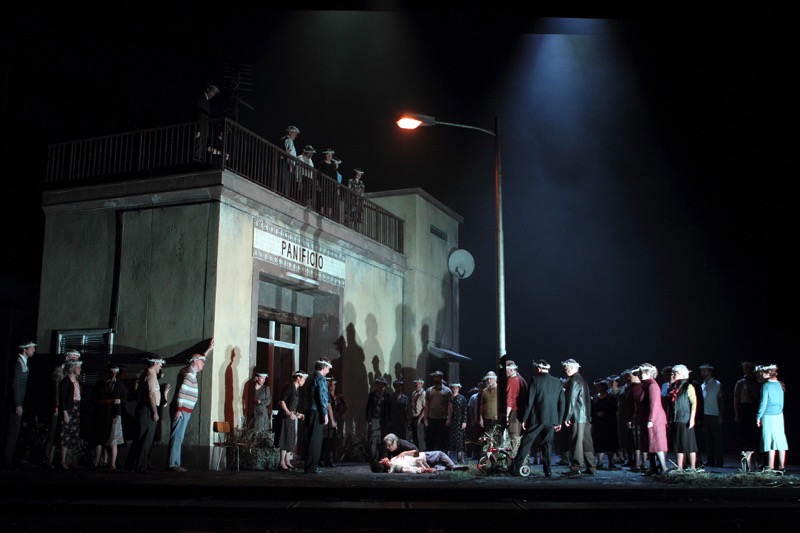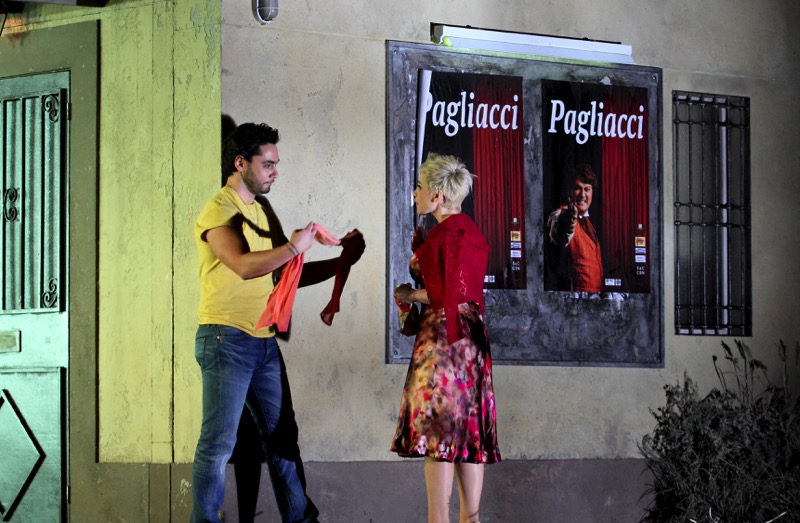Cavalleria rusticana and I Pagliacci, Cav and Pag, Royal Opera, ROH, Covent Garden, December 2015.
Posted on 4 December 2015Damiano Michieletto’s production of Rossini’s William Tell in June this year was widely panned, so I awaited his new production of Cav and Pag with some apprehension. I need not have.

Opening scene, all images ROH/ Catherine Ashmore
The gritty realism of Giovanni Verga’s 1880 short story Cavalleria Rusticana, later made into a play and taken up by the young composer Pietro Mascagni for his 1890 opera, has been updated by 100 years, but this is still a poor village in Verga’s Sicilian homeland. And the small school is where the acting troupe for Pagliacci puts on their play.

Mamma Lucia and Santuzza
Michieletto has combined the two stories. During the first opera posters for the play appear, and its leading lady Nedda meets her lover Silvio. He works in the bakery, owned by Turiddu’s mother Mamma Lucia, the realism enhanced with real dough going into the oven. During the second opera the abandoned Santuzza from Cavalleria Rusticana appears sobbing with Mamma Lucia, and the fate of her beloved and faithless Turiddu is emphasised during the overture as we see the villagers staring at his dead body before lifting it above their heads and carrying it off.

Silvio and Nedda meet during Cav
Trappings of the local Christianity are seen during the start of a Passion Play put on by the village children during Pagliacci, and a statue of the Madonna — carried in for the Easter Procession of Cav — raises a condemning arm at Santuzza, while the sudden lighting change indicates this is all in her mind. A similar lighting trick in Pagliacci allows the on-stage play to be carried on by doubles backstage as we see Canio descend into madness.

Nedda and Canio
An intriguing production of both operas with Antonio Pappano leading the orchestra and superb cast in a gripping evening of musical drama. Eva-Maria Westbroek carried huge conviction and terrific vocal power as the jilted Santuzza, and her big duet with the Turiddu of Aleksandrs Antonenko crackled with emotion. When he later fell to pieces backstage in Pagliacci his hugely natural Vesti la giubba brought the House down, with Carmen Giannattasio as an extremely attractive and wayward Nedda providing fine vocal passion with Dionysios Sourbis’s excellent Silvio.

Backstage fury: Tonio, Canio, Nedda
Very fine support from Elena Zilio (Mamma Lucia), Martina Belli (Lola) and Benjamin Hulett (Beppe), and as Alfio in Cav, and Tonio in Pag, Dimitri Platanias was a terrific vocal presence with a superb opening solo to set Leoncavallo’s opera in progress.
Despite the evident success of this new production, there was a scattering of boos for the production team at the end, but I hope and suspect this was due to a residual animosity about William Tell in the summer. Here the anger was entirely inappropriate.
Performances continue on various dates until January 1 with a live cinema relay on December 10 — for details click here.


A clever and convincing linkage of the two operas in production terms, and beautifully sung! The only slight problem with the revolve (which was in general extremely effective) was that some of the crowd scenes were very congested. From an amphitheatre seat it was all too plain that large areas of the stage were simply unavailable for use.